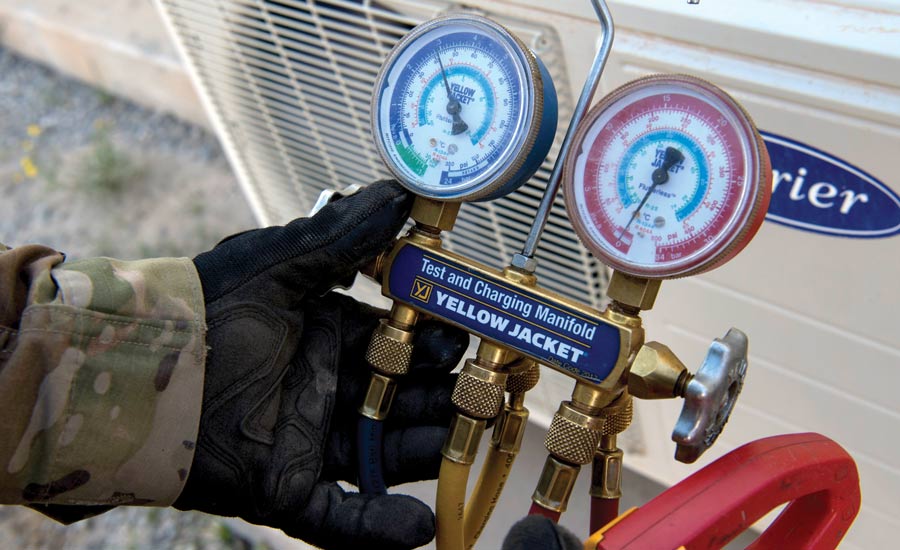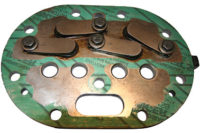The discharge line exiting the compressor is the hottest part of a refrigeration or air conditioning system. The compressor’s discharge line temperature can be measured by placing an insulated thermistor on the discharge line about 3 inches from the compressor. This discharge line temperature is a measure of the superheated refrigerant’s vapor temperature. Remember, superheated refrigerant refers to a refrigerant vapor that is at a higher temperature than its saturation temperature for a certain pressure. The certain pressure would be the condensing pressure for the high side of the system in this case.
The compressor’s discharge temperature can tell the service technician what is going on inside a refrigeration or air conditioning system. The compressor’s discharge temperature is a reflection of the hottest part of a refrigeration system, and there are limits as to how hot a discharge temperature should be.
Since the compressor’s discharge temperature is a superheated vapor temperature measurement, a pressure/temperature relationship does not exist, and a pressure gauge cannot be used for its measurement. Pressure gauges can only be used for a pressure/temperature relationship when a saturation temperature (evaporating and/or condensing) is needed.
The compressor’s discharge temperature is a reflection of what is going on inside the compressor, so it must be monitored very closely. The back of the compressor’s discharge valve is actually the hottest part of the system, but it is impossible for a service technician to measure. The next closest place, however, is the discharge line of the compressor.
TEMPERATURE LIMITS
If the compressor’s discharge line temperature gets higher than 225°F, the system may start to fail from worn rings, acid formations, and oil breakdown. Remember, if the discharge temperature is 225°F, the actual discharge valve temperature will be about 75°F hotter, which will bring the actual compressor’s discharge valve to 300°F. It is a known fact that most oil may start to break down and vaporize at 350°F. If this occurs, serious overheating problems will happen. Since compressor overheating problems are today’s most serious compressor field problems, service technicians must always monitor compressor discharge temperatures and keep them under 225°F.
HIGH COMPRESSOR DISCHARGE TEMPS
The main reasons for high compressor discharge temperatures include:
- High condensing pressures;
- Low suction pressures;
- High compression ratios; and
- High compressor superheats.
The causes for each of these four conditions are listed below.
Causes for high-condensing pressures can include:
- Dirty condenser coils;
- Burned out condenser fans;
- Broken fan belts;
- Undersized condenser coils;
- Overcharge of refrigerant;
- Non-condensables in the system;
- High ambient temperature; and
- Recirculated air over the condenser.
A high condensing temperature causes a high condensing pressure. In this case, the compressor must work harder — thus, generate more heat of compression — in compressing the suction pressure to the higher condensing pressures.
Causes for low suction pressures can include:
- Undercharged systems;
- TXV or capillary tubes underfeeding;
- Low evaporator heat loads;
- End of the cycle;
- Frosted evaporator coils;
- Evaporator fan out;
- Kinked suction lines;
- Plugged suction lines;
- Liquid line filters;
- Kinked liquid lines; and
- Plugged compressor inlet screens.
Again, more work — and more heat of compression — will be generated in compressing a lower suction pressure to the condensing pressure.
Causes for high compression ratios can include:
- Low suction pressures;
- High head pressures; and
- Combination of both low suction and high head pressure.
The higher the compression ratio, the higher the compressor’s discharge temperature will be. This happens because more heat of compression will be generated when compressing the gases through a greater pressure range.
Causes for high compressor superheats can include the evaporator being starved of refrigerant. Reasons for this can include:
- Restricted liquid lines;
- Undercharged system;
- Plugged filter drier;
- Kinked liquid lines; and
- TXV or capillary tube underfeeding.
THE FINAL VERDICT
In conclusion, compressor discharge temperatures reflect all of the latent heat absorbed in the evaporator, the evaporator superheat, all of the suction line superheat, and all of the heat of compression and motor generated heat at the compressor. It is at the discharge temperature where all of this heat is accumulated and must be rejected in the discharge line and condenser. Because the compressor’s discharge temperature is a reflection of what is going on inside the compressor, it must be monitored very closely.
See more articles from this issue here!








